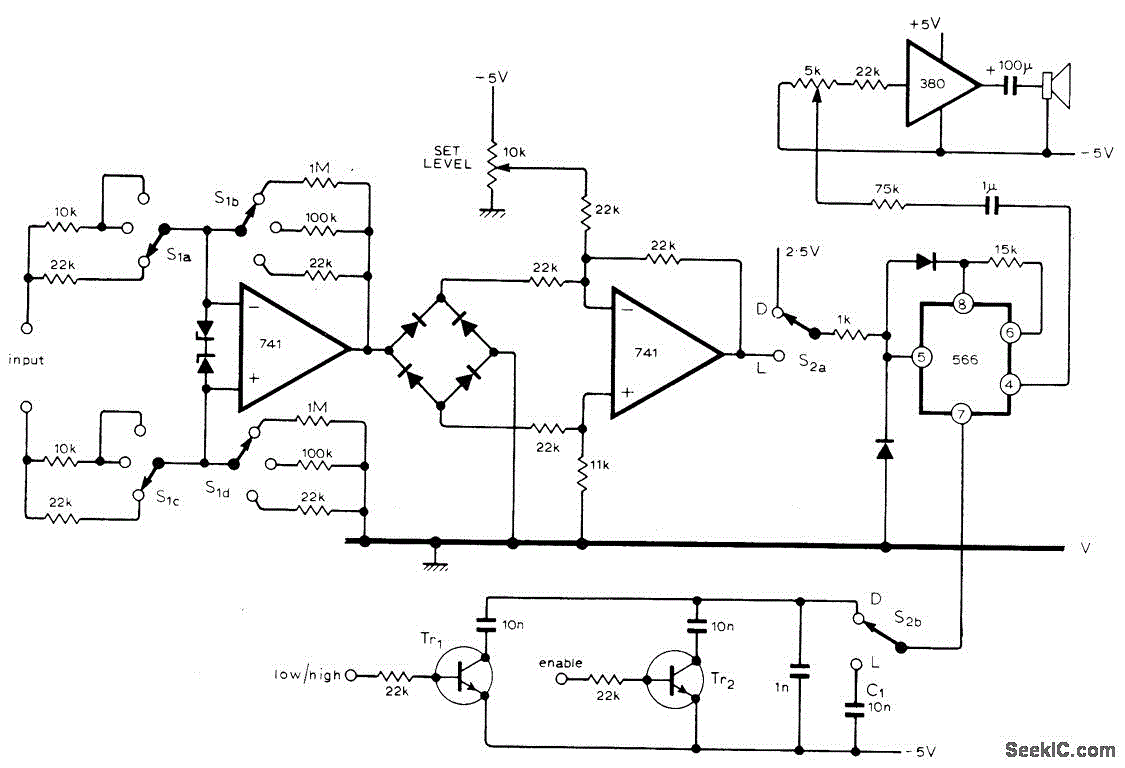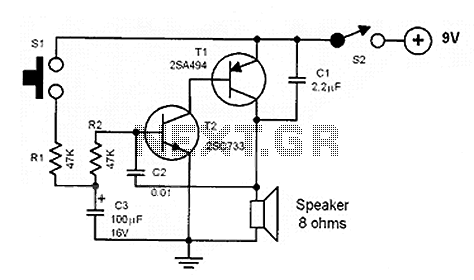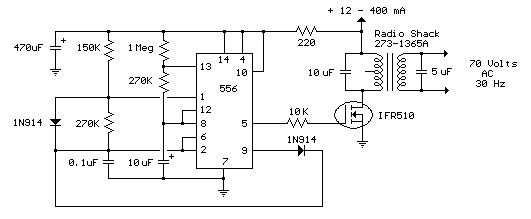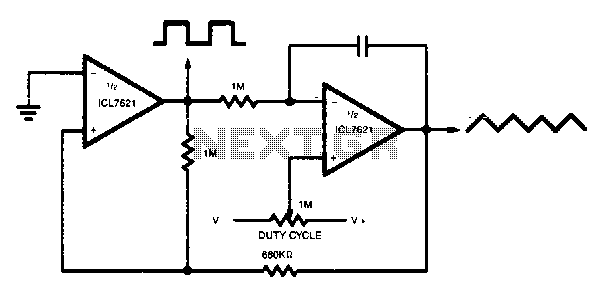
BINARY TONE GENERATOR FOR BLIND

When a low or high input voltage in binary form, as obtained from the converter circuit (also provided in the article) fed by a digital voltmeter, is applied, the circuit generates a low pitch for binary 0 and a high pitch for binary 1 when switch S2 is set to position D for digital voltmeter mode. A blind person can learn to recognize binary digits in tone form similarly to the way Morse code is learned. The circuit utilizes the LM566.
The described circuit employs the LM566 phase-locked loop (PLL) integrated circuit, which is designed to generate audio tones corresponding to binary inputs. The primary function of the circuit is to convert binary signals, represented as low (0) and high (1) voltage levels, into audible tones. This conversion allows individuals, particularly those with visual impairments, to interpret binary data audibly.
The circuit operates by taking a binary input voltage from a digital voltmeter, where a low voltage level corresponds to a binary 0 and a high voltage level corresponds to a binary 1. When switch S2 is set to the digital voltmeter mode (position D), the LM566 is configured to generate specific frequencies based on the binary input. The output frequency of the LM566 is modulated to produce a low pitch sound when the input is low and a high pitch sound when the input is high.
The design includes a power supply circuit to ensure the LM566 operates within its specified voltage range. Additional components, such as resistors and capacitors, are used to set the frequency response and stability of the output tones. The circuit can be enhanced with a speaker or headphone output stage to ensure that the generated tones are audible.
This auditory representation of binary data serves as an effective learning tool, allowing users to become proficient in recognizing binary digits through sound, akin to the way Morse code is communicated through different tones. The implementation of this circuit can significantly aid in accessibility for visually impaired individuals, providing them with a means to interact with digital information that would otherwise be visually represented.When low/high input is voltage in binary form, as obtained from converter circuit (also given in artide) fed by digital voltmeter, circuit produces Iow pitch for binary 0 and high pitch for binary 1 when S2 is set at D for digital voltmeter mode. Recognition of binary digits in tone form can be leamed by blind person much as leaming of Morse code.
Uses LM566.. 🔗 External reference
The described circuit employs the LM566 phase-locked loop (PLL) integrated circuit, which is designed to generate audio tones corresponding to binary inputs. The primary function of the circuit is to convert binary signals, represented as low (0) and high (1) voltage levels, into audible tones. This conversion allows individuals, particularly those with visual impairments, to interpret binary data audibly.
The circuit operates by taking a binary input voltage from a digital voltmeter, where a low voltage level corresponds to a binary 0 and a high voltage level corresponds to a binary 1. When switch S2 is set to the digital voltmeter mode (position D), the LM566 is configured to generate specific frequencies based on the binary input. The output frequency of the LM566 is modulated to produce a low pitch sound when the input is low and a high pitch sound when the input is high.
The design includes a power supply circuit to ensure the LM566 operates within its specified voltage range. Additional components, such as resistors and capacitors, are used to set the frequency response and stability of the output tones. The circuit can be enhanced with a speaker or headphone output stage to ensure that the generated tones are audible.
This auditory representation of binary data serves as an effective learning tool, allowing users to become proficient in recognizing binary digits through sound, akin to the way Morse code is communicated through different tones. The implementation of this circuit can significantly aid in accessibility for visually impaired individuals, providing them with a means to interact with digital information that would otherwise be visually represented.When low/high input is voltage in binary form, as obtained from converter circuit (also given in artide) fed by digital voltmeter, circuit produces Iow pitch for binary 0 and high pitch for binary 1 when S2 is set at D for digital voltmeter mode. Recognition of binary digits in tone form can be leamed by blind person much as leaming of Morse code.
Uses LM566.. 🔗 External reference





